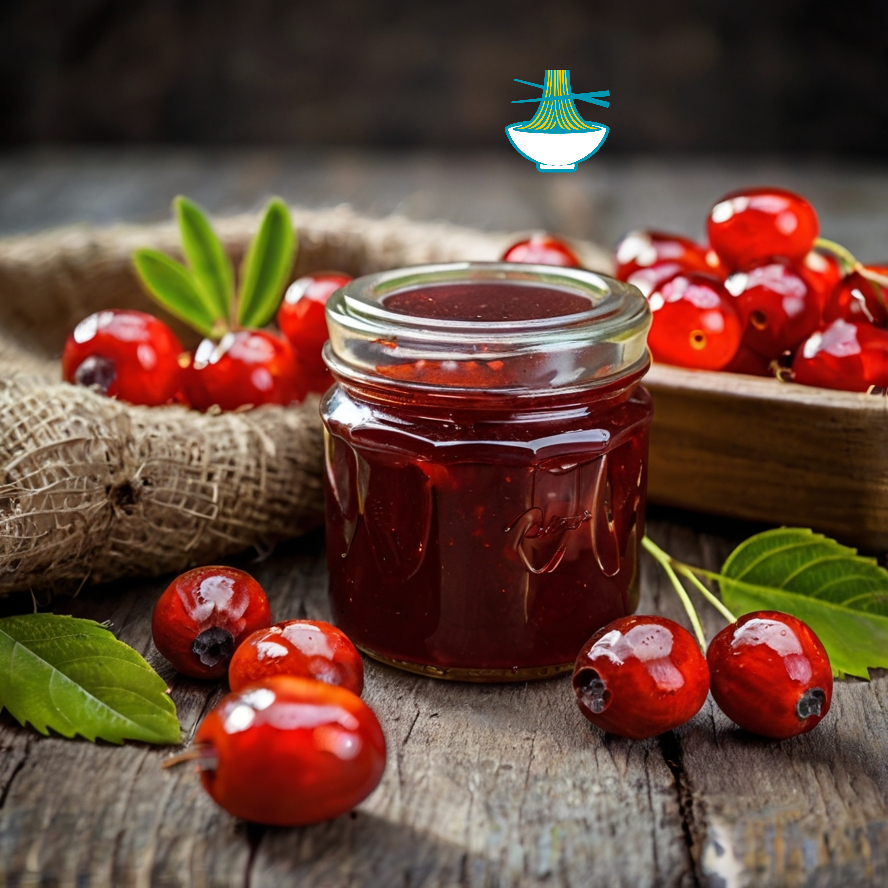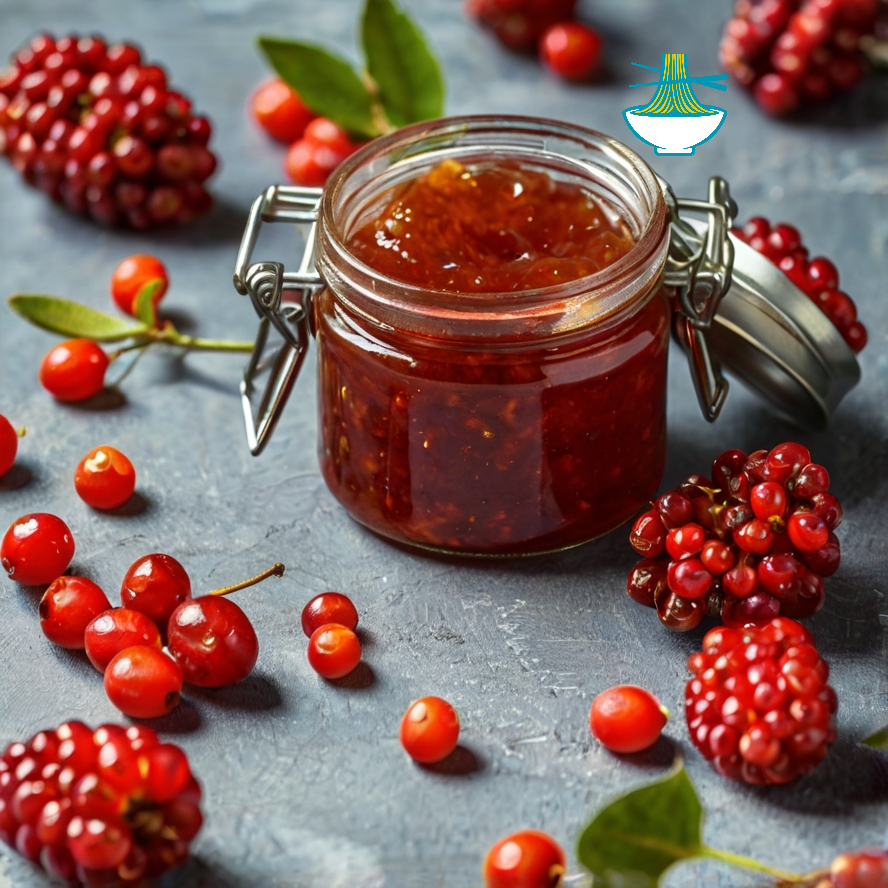Šermukšnių uogienė, or rowanberry jam, is a beloved treat in Lithuania, known for its unique tart flavor and bright red color. Made from the locally grown berries, this homemade jam is not only a delicious spread for bread but also an essential ingredient in many Lithuanian desserts. Rowanberries, often found in the wild across Lithuania, are rich in antioxidants, vitamins, and fiber, making this jam both nutritious and flavorful. The fruit itself is naturally tart, and when turned into jam, it is sweetened to balance its sharpness, resulting in a complex flavor profile that is both refreshing and satisfying. Šermukšnių uogienė is typically enjoyed during colder months and is a great accompaniment to various dishes or served as a topping for pastries and cakes. It’s a perfect example of how Lithuanians preserve the bounty of nature through simple yet delicious preserves and traditional recipes.
Ingredients:
- 1 kg rowanberries (fresh or frozen)
- 500g sugar
- 250ml water
- 1 lemon (juice and zest)
- 1 cinnamon stick (optional)
Instructions:
Got it! Here is the recipe formatted correctly in English, with the numbered list appearing properly when copied and pasted:
Rowanberry Jam Recipe
1. Prepare the Rowanberries:
- If using fresh rowanberries, carefully rinse them under cold water. Remove any stems, leaves, or unripe berries.
- If using frozen rowanberries, allow them to thaw at room temperature before proceeding.
2. Cook the Berries:
- In a large, heavy-bottomed pot, combine the rowanberries with 250ml of water.
- Place the pot over medium heat and bring the mixture to a simmer, stirring occasionally to prevent sticking and ensure even heat distribution.
- Once the berries begin to soften (about 10-15 minutes), use a masher or fork to gently crush them. This will release the juice and help the berries break down.
- Continue to simmer for another 5-10 minutes until the berries are completely softened and have released their juice.
3. Add Sugar and Lemon:
- Add 500g of sugar to the pot, along with the juice and zest of one lemon.
- Stir until the sugar is completely dissolved. The acidity from the lemon will help balance the tartness of the rowanberries.
4. Simmer the Jam:
- Allow the mixture to simmer gently over low to medium heat, stirring frequently.
- Continue simmering for about 20-30 minutes, or until the jam has thickened to your desired consistency.
- To test the consistency, place a small spoonful of jam on a cold plate and tilt the plate. If the jam holds its shape and doesn’t run, it’s ready.
- If using, add the cinnamon stick to the pot and allow it to simmer with the mixture for an additional 5 minutes to infuse the flavor.
5. Sterilize Jars:
- While the jam is simmering, prepare sterilized jars. Wash the jars and lids thoroughly in hot, soapy water, then rinse well.
- Place them in a preheated oven at 120°C (250°F) for 10-15 minutes, or boil them in water for 10 minutes to sterilize.
6. Jar the Jam:
- Once the jam has reached your desired thickness and the cinnamon stick has been removed (if used), carefully pour the hot jam into the sterilized jars.
- Use a funnel to prevent spills and ensure each jar is filled to the top.
7. Seal and Store:
- Immediately seal the jars with the sterilized lids.
- Allow the jars to cool to room temperature.
- Once cooled, store the jars in a cool, dark place for up to a year. The jam should be sealed properly and free of air bubbles to prevent spoilage.
Tips for Success:
- Consistency Check: To ensure the perfect consistency, use the cold plate method. If the jam gels, it’s ready. If it's too runny, cook a little longer.
- Flavor Variation: You can experiment with additional spices like nutmeg or cloves, or substitute lemon with orange zest for a unique twist on the flavor.
Tips for Making Rowanberry Jam:
For Beginners:
- Use a large, heavy-bottomed pot to prevent burning.
- Stir frequently to avoid the jam sticking to the pot.
- Test the consistency by placing a small amount of jam on a cold plate; if it gels, it’s ready.
Sweetener Alternatives:
- Replace sugar with honey or maple syrup for a more natural sweetener.
- Use stevia or erythritol for a low-calorie alternative, adjusting quantities as these are sweeter than sugar.
Enhancing Flavors:
- Add spices like nutmeg or cloves for a unique twist.
- Experiment with citrus additions such as orange zest instead of lemon for a different flavor profile.
Note:
Deeper Nutritional Insights:
Impact of Cooking on Vitamin C:
- Cooking reduces vitamin C content by approximately 30-50%. To retain maximum nutrients, simmer gently and avoid overcooking.
Comparison with Other Jams:
- Rowanberry jam typically contains less sugar than commercial jams, making it slightly lower in calories. It also offers higher antioxidant levels compared to jams made from sweeter fruits like strawberries or apricots.
Additional Uses of Rowanberry Jam:
- Dessert Pairings: Rowanberry jam complements desserts such as cheesecakes, tarts, and sponge cakes. Spread it over a layer of custard in a tart shell or drizzle it over a plain vanilla cake for a tangy kick.
- Breakfast Ideas: Add a dollop of rowanberry jam to oatmeal or use it as a topping for pancakes, waffles, or French toast.
- Creative Uses: Mix the jam into plain yogurt for a flavorful breakfast or snack. Alternatively, blend it into smoothies for an added tartness that balances sweeter fruits like bananas or strawberries.
- Savory Pairings: Serve the jam with cheese platters, especially sharp cheddar or brie. It also pairs well with roasted meats like duck or pork, offering a sweet and tangy contrast.
Frequently Asked Questions:
1. Can the jam be stored for a long time? What is the best method?
- Yes, rowanberry jam can be stored for up to a year if properly sealed in sterilized jars. Ensure jars are cleaned thoroughly and heated before filling. After sealing, store them in a cool, dark place.
2. Can other berries be used to make this jam?
- Yes, you can substitute rowanberries with cranberries, red currants, or even a mix of berries. However, the flavor profile will vary.
3. How can I reduce the sweetness of the jam?
- Use less sugar or add tart fruits like unsweetened apple puree. A pinch of salt can also help balance excessive sweetness.
4. What are the health benefits of rowanberries compared to other fruits?
- Rowanberries are exceptionally high in vitamin C and antioxidants. While fruits like blueberries or cranberries also offer antioxidants, rowanberries stand out for their immune-boosting properties and unique tart flavor.
5. How can I tell if the jam is ready?
- Place a small amount of jam on a cold plate and tilt it. If it forms a gel-like consistency and doesn’t run, it’s ready.
6. What are the differences between fresh and frozen berries?
- Fresh berries provide a slightly firmer texture, while frozen berries can be more convenient and break down faster during cooking. Both are suitable for making jam.
7. Is this jam suitable for gluten-free or vegan diets?
- Yes, rowanberry jam is naturally gluten-free and vegan. Ensure that any added sweeteners or flavorings align with dietary preferences.
8. How does this jam compare nutritionally to store-bought jams?
- Homemade rowanberry jam has fewer preservatives and artificial additives. It retains more natural antioxidants and vitamins, especially when using minimal processing and natural sweeteners.
9. What’s the best way to sterilize jars?
- Wash jars and lids with hot, soapy water. Rinse well and place them in a preheated oven at 120°C (250°F) for 10-15 minutes. Alternatively, boil them in water for 10 minutes before filling.

Nutritional values and benefits
1 kg Rowanberries
- Calories: 500
- Carbohydrates: 120g
- Protein: 2g
- Fat: 1g
- Sodium: 10mg
- Vitamins:
- Vitamin C: 500mg (833% DV)
- Vitamin A: 100 IU (2% DV)
Nutritional Benefit: Rowanberries are an excellent source of vitamin C, which supports immune health and collagen production. They also contain antioxidants that help protect the body from oxidative stress and inflammation.
500g Sugar
- Calories: 1,960
- Carbohydrates: 500g
- Protein: 0g
- Fat: 0g
- Sodium: 0mg
Nutritional Benefit: Sugar helps to balance the tartness of the rowanberries and acts as a preservative, allowing the jam to be stored for longer periods. However, it should be consumed in moderation due to its high glycemic index.
250ml Water
- Calories: 0
- Carbohydrates: 0g
- Protein: 0g
- Fat: 0g
- Sodium: 0mg
Nutritional Benefit: Water is essential for hydration and helps dissolve the sugar and juice from the berries, creating the jam’s smooth texture.
1 Lemon (Juice and Zest)
- Calories: 12
- Carbohydrates: 4g
- Protein: 0g
- Fat: 0g
- Sodium: 1mg
- Vitamins:
- Vitamin C: 30mg (50% DV)
Nutritional Benefit: Lemon juice adds a refreshing acidity that enhances the flavor of the jam, while the zest provides additional antioxidants and vitamin C, which promote skin health and immunity.
1 Cinnamon Stick (optional)
- Calories: 6
- Carbohydrates: 2g
- Protein: 0g
- Fat: 0g
- Sodium: 0mg
Nutritional Benefit: Cinnamon has anti-inflammatory properties and may help regulate blood sugar levels. It also adds a warm, comforting flavor to the jam.
Summary of Nutritional Benefits:
Šermukšnių uogienė is a delicious way to enjoy the health benefits of rowanberries, which are high in vitamin C and antioxidants. The jam offers a good amount of natural sweetness, but the addition of sugar should be considered when monitoring calorie intake. The lemon and cinnamon add not only flavor but also additional health benefits, such as supporting the immune system and reducing inflammation. This rowanberry jam is a wonderful addition to your pantry, offering both nutritional benefits and a rich, tangy flavor that enhances many meals and desserts.


Comments